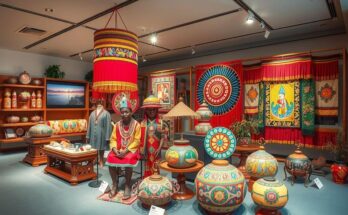At the eighth China Intangible Cultural Heritage Expo, advanced 3D technology enthralls visitors as a lifelike ancient wine vessel showcases the art of cloisonne. Interactive exhibits, such as virtual tai chi and augmented reality fair experiences, bridge cultural gaps, allowing participants to connect with their heritage in dynamic ways. These innovations emphasize the importance of modernizing traditional crafts to foster engagement and appreciation among younger generations.
In the vibrant heart of Beijing at the eighth China Intangible Cultural Heritage Expo, a magnificent three-dimensional representation of an ancient wine vessel, known as a zun, captivates viewers without the need for virtual reality gear. Instead, with just a screen and built-in cameras, attendees revel in the lifelike movement of this artifact as it floats and spins, illustrating the intricate craftsmanship of cloisonne, a revered art form. This technological marvel, developed by Su Gaofeng, a dedicated faculty member at Beijing Union University’s College of Art, seamlessly brings ancient traditions into the modern world. Su, speaking of the project’s imaginative execution, outlined how detailed 3D modeling recreates the entire cloisonne production process—from initial sketches to the artful enamel firing, a stage where temperatures soar above 800 degrees Celsius. The effort aims to bridge the gap between complex artistry and public appreciation, enabling spectators to grasp the delicate nuances that define traditional crafts. By blending augmented reality with the traditional art, visitors engage in an interactive experience—using AR pens to explore various production stages firsthand. The expo champions the glorious tapestry of intangible cultural heritage, showcasing notable items and achievements since China’s inclusion in the UNESCO Convention. Compelling exhibits highlight tai chi’s rising popularity among the youth, featuring virtual instructors guiding practitioners in serene settings. Zhang Qian, director of the lab behind this innovation, notes how they designed a system that adapts to users’ movements through cutting-edge motion-sensing technology, ensuring an interactive and enriching experience that honors tai chi’s rich cultural significance. Amidst the festivities, visitors can also indulge in the Majie Quyi fair via an AR experience, breathing life into centuries-old performances that celebrate Chinese folk arts. This immersive digital environment invites attendees to virtually participate, touching instruments and engaging with performers to appreciate the fair’s joyous spirit from centuries past. Likewise, participants can delight in an indoor kite-flying experience that intertwines childhood nostalgia with modern tech, allowing individuals to manage kites through a digital interface inspired by traditional Southern Chinese artistry. The push for digitalization has accelerated markedly since 2017, fostering a renaissance of cultural connection that immerses participants in crafts long cherished by previous generations. Liu Xinchen, from Zhejiang Guangsha Vocational and Technical University, underscores that these experiences promote engagement and understanding, transforming passive spectators into active participants, cultivating a new generation appreciative of their heritage. Such is the beauty of blending technology with tradition: it not only breathes new life into age-old crafts but forges lasting connections across time, allowing our cultural legacies to thrive and evolve.
The article illustrates the innovative fusion of digital technology and traditional crafts at the recent China Intangible Cultural Heritage Expo. As China aims to preserve its cultural heritage through modernization, the use of 3D and augmented reality enables vivid representations of historical art forms, immersing the public in interactive experiences. Highlighting achievements over the past two decades, the expo exemplifies how cultural practices can evolve and remain relevant while honoring ancient craftsmanship.
The successful integration of digital technology with traditional Chinese crafts at the expo reveals the potential for cultural revival and educational outreach. By making heritage experiences more accessible and engaging, these innovations foster a deeper understanding and appreciation for the intricacies of historical art forms. As technology continues to evolve, it will undoubtedly open new avenues for preserving and inspiring future generations to cherish their cultural legacies.
Original Source: asianews.network



